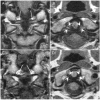Are MRI high-signal changes of alar and transverse ligaments in acute whiplash injury related to outcome?
- PMID: 21070654
- PMCID: PMC2989946
- DOI: 10.1186/1471-2474-11-260
Are MRI high-signal changes of alar and transverse ligaments in acute whiplash injury related to outcome?
Abstract
Background: Upper neck ligament high-signal changes on magnetic resonance imaging (MRI) have been found in patients with whiplash-associated disorders (WAD) but also in non-injured controls. The clinical relevance of such changes is controversial. Their prognostic role has never been evaluated. The purpose of this study was to examine if alar and transverse ligament high-signal changes on MRI immediately following the car accident are related to outcome after 12 months for patients with acute WAD grades 1-2.
Methods: Within 13 days after a car accident, 114 consecutive acute WAD1-2 patients without prior neck injury or prior neck problems underwent upper neck high-resolution proton-weighted MRI. High-signal changes of the alar and transverse ligaments were graded 0-3. A questionnaire including the impact of event scale for measuring posttraumatic stress response and questions on patients' expectations of recovery provided clinical data at injury. At 12 months follow-up, 111 (97.4%) patients completed the Neck Disability Index (NDI) and an 11-point numeric rating scale (NRS-11) on last week neck pain intensity. Factors potentially related to these outcomes were assessed using multiple logistic regression analyses.
Results: Among the 111 responders (median age 29.8 years; 63 women), 38 (34.2%) had grades 2-3 alar ligament changes and 25 (22.5%) had grades 2-3 transverse ligament changes at injury. At 12 months follow-up, 49 (44.1%) reported disability (NDI > 8) and 23 (20.7%) neck pain (NRS-11 > 4). Grades 2-3 ligament changes in the acute phase were not related to disability or neck pain at 12 months. More severe posttraumatic stress response increased the odds for disability (odds ratio 1.46 per 10 points on the impact of event scale, p = 0.007) and so did low expectations of recovery (odds ratio 4.66, p = 0.005).
Conclusions: High-signal changes of the alar and transverse ligaments close after injury did not affect outcome for acute WAD1-2 patients without previous neck problems. High-resolution upper neck MRI has limited value for the initial examination and follow-up of such patients.
Figures

Similar articles
-
Magnetic resonance imaging signal changes of alar and transverse ligaments not correlated with whiplash-associated disorders: a meta-analysis of case-control studies.Eur Spine J. 2013 Jan;22(1):14-20. doi: 10.1007/s00586-012-2490-x. Epub 2012 Nov 10. Eur Spine J. 2013. PMID: 23143091 Free PMC article. Review.
-
Magnetic resonance imaging of the alar and transverse ligaments in acute whiplash-associated disorders 1 and 2: a cross-sectional controlled study.Spine (Phila Pa 1976). 2011 Mar 15;36(6):E434-40. doi: 10.1097/BRS.0b013e3181da21a9. Spine (Phila Pa 1976). 2011. PMID: 21178847
-
Whiplash-associated disorders impairment rating: neck disability index score according to severity of MRI findings of ligaments and membranes in the upper cervical spine.J Neurotrauma. 2005 Apr;22(4):466-75. doi: 10.1089/neu.2005.22.466. J Neurotrauma. 2005. PMID: 15853463
-
Follow-up MR imaging of the alar and transverse ligaments after whiplash injury: a prospective controlled study.AJNR Am J Neuroradiol. 2011 Nov-Dec;32(10):1836-41. doi: 10.3174/ajnr.A2636. Epub 2011 Sep 15. AJNR Am J Neuroradiol. 2011. PMID: 21920865 Free PMC article. Clinical Trial.
-
[Mystery of alar ligament rupture: value of MRI in whiplash injuries--biomechanical, anatomical and clinical studies].Rofo. 2007 Nov;179(11):1127-36. doi: 10.1055/s-2007-963426. Rofo. 2007. PMID: 17948191 Review. German.
Cited by
-
The nosological classification of whiplash-associated disorder: a narrative review.J Can Chiropr Assoc. 2021 Apr;65(1):76-93. J Can Chiropr Assoc. 2021. PMID: 34035543 Free PMC article.
-
Are two readers more reliable than one? A study of upper neck ligament scoring on magnetic resonance images.BMC Med Imaging. 2013 Jan 17;13:4. doi: 10.1186/1471-2342-13-4. BMC Med Imaging. 2013. PMID: 23327567 Free PMC article.
-
Magnetic resonance imaging signal changes of alar and transverse ligaments not correlated with whiplash-associated disorders: a meta-analysis of case-control studies.Eur Spine J. 2013 Jan;22(1):14-20. doi: 10.1007/s00586-012-2490-x. Epub 2012 Nov 10. Eur Spine J. 2013. PMID: 23143091 Free PMC article. Review.
-
Classifying Whiplash Recovery Status Using the Neck Disability Index: Optimized Cutoff Points Derived From Receiver Operating Characteristic.J Chiropr Med. 2016 Jun;15(2):95-101. doi: 10.1016/j.jcm.2016.04.011. Epub 2016 May 26. J Chiropr Med. 2016. PMID: 27330511 Free PMC article.
-
Post-Traumatic Atlanto-Axial Instability: A Combined Clinical and Radiological Approach for the Diagnosis of Pathological Rotational Movement in the Upper Cervical Spine.J Clin Med. 2023 Feb 12;12(4):1469. doi: 10.3390/jcm12041469. J Clin Med. 2023. PMID: 36836004 Free PMC article.
References
-
- Dvorak J, Panjabi MM. Functional anatomy of the alar ligaments. Spine (Phila Pa 1976) 1987;12:183–189. - PubMed
-
- Heller JG, Amrani J, Hutton WC. Transverse ligament failure: a biomechanical study. J Spinal Disord. 1993;6:162–165. - PubMed
-
- Saldinger P, Dvorak J, Rahn BA, Perren SM. Histology of the alar and transverse ligaments. Spine (Phila Pa 1976) 1990;15:257–261. - PubMed
Publication types
MeSH terms
LinkOut - more resources
Full Text Sources
Medical

